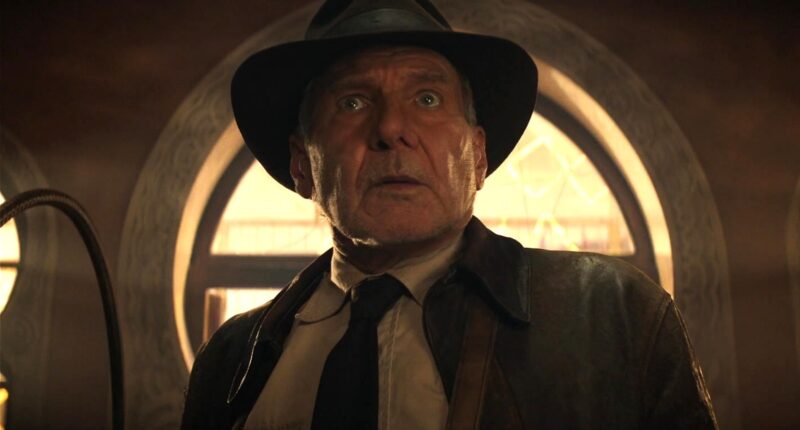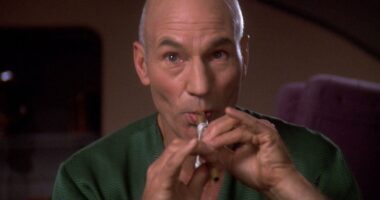Share this @internewscast.com
Hollywood has come to see legacy sequels as a reliable source of revenue. At the time of writing, “Star Wars: The Force Awakens” holds the record for the highest-grossing domestic film, epitomizing this trend. Nostalgia-driven films like “Spider-Man: No Way Home” and “Top Gun: Maverick” have further cemented the financial success of this kind of movie, especially in the aftermath of the pandemic. However, even popular genres aren’t immune to financial flops. For every hit like 2018’s “Halloween” or 2024’s “Beetlejuice Beetlejuice,” numerous sequels merely evoked a lukewarm audience response.
Not even the drawing power of a cherished franchise name or returning actors could ensure these sequels turned a profit. The causes of these box office failures varied greatly. Some were based on intellectual properties that were already worn out by the time a sequel emerged. Others attempted to follow films that were never major hits. Some productions squandered large budgets without the fan support necessary to recoup those investments. These outcomes underscore that sometimes it’s better to let a franchise retire peacefully than to seek a fleeting financial gain.
Spinal Tap II: The End Continues
Although now hailed as a classic satirical comedy, the original “This is Spinal Tap” didn’t fare well in theaters upon its 1984 release, earning only $5.75 million domestically. Its mockumentary style and cutting humor were too advanced for audiences at the time. While it has since built a strong cult following, its status as a pioneering comedy has waned, as the market now has plenty of similar mockumentaries. The film’s stars (Christopher Guest, Michael McKean, and Harry Shearer) haven’t had significant movie roles in recent decades. Consequently, a sequel like “Spinal Tap II: The End Continues” struggled to capture contemporary interest.
Few anticipated just how poorly “Spinal Tap II” would perform. It made only $1.61 million during its opening weekend despite being shown in 1,920 theaters and costing $22.65 million to produce. Adding to the misfortune, “Spinal Tap II” was distributed in North America by Bleecker Street, a smaller independent label with limited box office successes. Given these dire numbers, it’s evident audiences weren’t eager for a return performance like “Spinal Tap II: The End Continues.”
The Exorcist: Believer
The 1973 film “The Exorcist” remains a landmark R-rated movie in terms of both success and influence. However, subsequent “Exorcist” films failed to replicate this box-office magic. Before 2023, no sequel reached beyond $42 million domestically, a small fraction of the original’s domestic earnings. While “The Exorcist” was well-loved, audiences were uninterested in endless sequels akin to the “Friday the 13th” series. Nevertheless, Blumhouse and Universal pressed forward with a new trilogy of “Exorcist” sequels, starting with 2023’s “The Exorcist: Believer,” much like they did with “Halloween” in the late 2010s.
Despite the buzz around Blumhouse and the return of Ellen Burstyn from the original film, “Believer” couldn’t escape the financial pitfalls that hampered previous sequels. It grossed only $65.53 million domestically and $136.99 million worldwide, a poor showing given Universal’s $400 million investment in the trilogy. The domestic earnings of “Believer” fell short of the three-day opening haul of 2018’s “Halloween,” a stark indicator that the sequel series missed the mark.
You don’t need to be a paranormal expert or high-ranking Catholic priest to know why “The Exorcist: Believer” stumbled financially. People had been staying away from “Exorcist” follow-ups for decades, so why would this particular installment, even with Burstyn and the Blumhouse logo in tow, be any different?
Superman Returns
While 2005’s “Batman Begins” acted as a cinematic reset of the Batman mythos, the following year’s “Superman Returns” was intended as a legacy sequel to the original Christopher Reeve “Superman” movies, now with Brandon Routh donning the red cape. This approach aimed to stoke nostalgia from audiences with fond memories of seeing those initial “Superman” titles, complete with the return of Marlon Brando as Jor-El (via archival footage). Unfortunately, along with ending Brandon Routh’s acting career, “Superman Returns” didn’t quite set the box office on fire.
On the surface, its $200 million domestic haul doesn’t seem terrible, being roughly on par with the domestic cume of director Bryan Singer’s “X2: X-Men United” released three years prior. However, the film only grossed $191.96 million overseas, a disappointing sum made extra painful by its massive $232 million budget, somehow costing even more than that summer’s big juggernaut “Pirates of the Caribbean: Dead Man’s Chest.” “Returns” only opening a week before “Dead Man’s Chest” shattered box office records also didn’t help it stand out as a must-see blockbuster.
Suddenly, that $200 million North American haul looks mighty pitiful. At the end, it wasn’t Kryptonite that took down this Superman. Instead, being too tethered to the past was a hindrance to a larger box office sum.
I Know What You Did Last Summer
It’s clear that 2025’s “I Know What You Did Last Summer” was molded after the success of similar legacy sequels to “Scream” and “Halloween,” right down to reusing the moniker of the franchise’s first entry. The problem, though, was that the “Last Summer” movies were never as big as these horror titles. The first three “Scream entries grossed more domestically than the worldwide haul of the entire “Last Summer” franchise. Heck, even the original “Halloween,” when adjusted for inflation, made roughly $232.5 million domestically, outgrossing the $228.6 million-earning “Last Summer” series.
All of this is to say that there simply wasn’t a massive enough fanbase anticipating a “Last Summer” legacy sequel. Plus, there wasn’t as much novelty to seeing the original “Last Summer” cast make a big screen return. Promising Freddie Prinze Jr. and Jennifer Love Hewitt in a 2025 horror movie didn’t have the same appeal as the once-in-a-lifetime opportunity of seeing Harrison Ford step back onto the Millennium Falcon or Jamie Lee Curtis go head-to-head with Michael Myers once again. All of this ensured that 2025’s “I Know What You Did Last Summer” would underwhelm, grossing only $32.15 million domestically.
That’s roughly on par with the opening weekend of 2022’s “Scream,” a microcosm of how this legacy sequel failed mimicking the box office success of its contemporaries.
The Matrix Resurrections
Opening too closely to “The Matrix Reloaded” and divisive word-of-mouth resulted in “The Matrix Revolutions” making considerably less at the box office. However, there was still enough buzz surrounding the “Matrix” brand that bringing this saga back to theaters with “The Matrix Resurrections” in December 2021 seemed a lucrative move. In addition, Keanu Reeves’ recent success with the “John Wick” franchise should’ve further bolstered its box office. Unfortunately, “The Matrix Resurrections” opened five days after “Spider-Man: No Way Home,” which remains the biggest domestic earner released after March 2020 and is still one of the only movies to gross $1 billion after the pandemic.
As a result of the web-crawler sucking up all the oxygen in the room, “Resurrections” bombed at the box office, only grossing $40.46 million domestically and $160.16 million worldwide on a $190 million budget. The legacy sequel was also the final 2021 Warner Bros. movie to simultaneously premiere in theaters and on HBO Max, a maneuver that undoubtedly stifled its must-see appeal in theaters.
Bigger problems were at play beyond Spidey and streaming. The largest issue simply seemed to be that audiences didn’t want more “Matrix” 18 years after “Revolutions.” Even under the best circumstances, it would’ve been near impossible to combat that mainstream apathy towards the franchise. While external factors certainly didn’t help it out financially, Neo and company faced tremendous odds from the get-go.
Indiana Jones and the Dial of Destiny
Legacy sequels are common in modern Hollywood. Rarely, though, does a legacy sequel directly follow up another legacy sequel, as was the case with 2023’s “Indiana Jones and the Dial of Destiny,” an extension of 2008’s “Indiana Jones and the Kingdom of the Crystal Skull.” Dealing with the 1950s and an unexpected son informed “Crystal Skull,” while “Dial of Destiny” centers on time-travel, resurfacing Nazis, and the after effects of the Space Race. At its core, however, “Dial of Destiny” retreads thematic territory from “Crystal Skull,” underscoring why this entry struggled to find its footing at the box office.
Audiences had already seen one blockbuster about a grizzled Indiana Jones navigating a post-World War II world. What more could “Dial of Destiny,” offer, especially since this one wasn’t directed by Steven Spielberg? Then there was the fact that the movie cost a whopping $300 million to make, an eye-popping sum that meant this James Mangold directorial effort would’ve needed to become one of the biggest movies of all-time to break a profit for Disney and Lucasfilm.
Unsurprisingly, with the novelty of an “Indiana Jones” legacy sequel having been exploited once before, “Indiana Jones and the Dial of Destiny” was a bomb with just $174.48 million domestically and a $383.96 million worldwide gross. With those numbers, don’t expect to see more double-dipped legacy sequels like “Dial of Destiny” anytime soon.
Blade Runner 2049
In 2011, production company Alcon Entertainment jumped into the franchise cinema fray by purchasing the rights to make a slew of sequels and spin-offs to the classic 1982 sci-fi film “Blade Runner.” The first of these was “Blade Runner 2049,” which brought back Harrison Ford and paired him up with new leads Ryan Gosling and Ana de Armas for an expansive motion picture that cost an excessive $185 million.The hope was that “Blade Runner’s” cult fanbase and tremendous influence on pop culture would result in “Blade Runner 2049” becoming a box office sensation and propel Alcon for years to come.
However, despite glowing critical praise and even two Oscar wins, “Blade Runner 2049” came up severely short at the box office. Domestically, it only grossed $92.05 million, while worldwide it amassed just $259.15 million. To say that was under expectations is a massive understatement. Part of the problem was that the original “Blade Runner,” though beloved by sci-fi film geeks was, itself, initially a box office bomb. Even after 35 years of reappraisal, it may have still been too cerebral and impenetrable for the general public, with even producer and original “Blade Runner” director Ridley Scott claiming that the film was too slowly paced. Gosling’s mixed box office track record as a leading man didn’t help either.
Whatever the reason for its box office woes, Alcon Entertainment’s hopes circa. 2011 never materialized. “Blade Runner 2049” was one legacy sequel that wasn’t a money-printing machine for its financiers.
Independence Day: Resurgence
“Independence Day: Resurgence’s” box office woes boiled down to two words: Will Smith. Without the original “Independence Day” leading man and breakout star back to headline the follow-up, “Resurgence” had an aura of pointlessness hanging over it. However, there were other equally momentous problems facing this project, which only beamed up $103.14 million in its domestic run and just $384.16 million worldwide.
For one thing, “Resurgence’s” marketing didn’t have the kind of memorable imagery that defined Roland Emmerich’s past disaster blockbusters, such as the White House blowing up in the first “Independence Day” or the gigantic waves crashing over the mountains in “2012.” “Resurgence’s” trailers, in contrast, climaxed with grimy, uninspired images of a digital London getting decimated. To boot, the sequel’s “star power” was incredibly lacking. The biggest name on display was Liam Hemsworth, a man who’s never been much of a box office draw outside of the “Hunger Games” titles. Other newcomers, like Charlotte Gainsbourg and Jessie Usher, similarly failed to move the needle.
“Resurgence” even got hurt by that summer’s earlier 20th Century Fox tentpole “X-Men: Apocalypse,” which already satisfied audiences’ cravings for maximalist disaster cinema. However, without Will Smith to mine nostalgia, this legacy sequel was always going to crater.
Doctor Sleep
At the start of 2019, Warner Bros. made a major release date adjustment to writer-director Mike Flanagan’s “The Shining” sequel “Doctor Sleep.” Once set to debut in January 2020, Warner Bros. shifted the title up to November 8, 2019. The move signified that Warner Bros. had hopes that the film, based on Stephen King’s 2013 novel, could become a breakout hit akin to 2017’s “It.” Unfortunately, that never happened. “Doctor Sleep” only grossed $72.4 million worldwide, including a $31.6 million domestic take, a deeply disappointing sum considering initial predictions of a $30 million North American opening weekend.
Given how beloved “The Shining” is, a legacy sequel anchored by Ewan McGregor, on paper, should’ve been a financial slam-dunk. However, some key problems plagued this project. For one thing, Stephen King’s “Doctor Sleep” book isn’t a household name. Average folks just glancing at billboards or posters might not even know it was a “Shining” sequel. It’s also worth noting that McGregor, outside of the “Star Wars” prequels and 2017 “Beauty and the Beast” remake, has only seen two live-action releases (“Angels & Demons” and “Black Hawk Down”) crack $100+ million domestically, neither of which saw him in the starring role.
Between the obscure source material and McGregor’s erratic box office track record, “Doctor Sleep” was also going to face immense box office hurdles, no matter what high-profile release date Warner Bros. assigned to it.
Terminator: Dark Fate
The battle for “Terminator: Dark Fate’s” box office destiny was lost before it began. While “Terminator 2: Judgement Day” was one of the biggest films of all-time when it grossed $203.46 million domestically in 1991, the slew of underwhelming sequels that followed would inevitably dilute the franchise’s legacy and box office earnings. 2015’s “Terminator: Genisys” even became the first entry to miss the $100+ million mark in North America. No longer did moviegoers associate the “Terminator” brand with revolutionary visual effects and cool Arnold Schwarzenegger quips. Instead, dumb franchise callbacks, repellently drab color schemes, and idiotic titles were at the forefront of people’s minds.
It wasn’t surprising that “Terminator: Dark Fate” cratered at the box office with a measly $62.25 million domestic haul and only $250.36 million worldwide. Its failure was especially head-turning given its $185 million budget and despite playing the traditional legacy sequel playbook to a tee. However, ads hyping up Linda Hamilton returning as Sarah Connor didn’t have the same pull as they could have had in a pre-“Salvation”https://www.looper.com/”Genisys” world. Likewise, highlighting Schwarzenegger playing a Terminator once more also had no appeal since he’d already been the lead of “Genisys” four years earlier.
Even having James Cameron as producer didn’t guarantee success, since audiences typically don’t turn out to films he isn’t also directing. No famous name could save legacy sequel “Dark Fate” from the “Terminator” franchise’s atrocious reputation.








